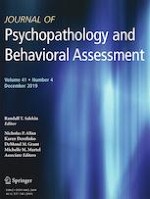16-07-2019
Psychometric Properties of the Emotion Reactivity Scale in Community Screening Assessments
Gepubliceerd in: Journal of Psychopathology and Behavioral Assessment | Uitgave 4/2019
Log in om toegang te krijgenAbstract
Among individuals experiencing internalizing psychopathology, high levels of emotion reactivity—the degree to which they experience emotions strongly or intensely, over extended periods of time, and as elicited by a variety of stimuli—increase risk for self-injurious thoughts and behaviors. Researchers developed the Emotion Reactivity Scale (ERS) to assess emotion reactivity, with psychometric support for the measure largely restricted to at-risk clinical populations. We know little of the psychometric properties of the ERS when administered as a screening measure in community assessments. In a study of the psychometric properties of the ERS in a non-clinical assessment of adults, we recruited 105 participants (Mage = 44.6; 82.9% female) as part of a larger study of adolescent social anxiety and family relationships. Participants completed the ERS, self-report measures of various psychosocial domains, and an impromptu speech task, before and during which they self-reported their arousal. Scores taken from the ERS demonstrated strong internal consistency and demonstrated facets of validity: (a) positive relations with measures of internalizing psychopathology and parent-adolescent conflict, and negative relations with a measure of quality of life (convergent validity); (b) relations with self-reported anxiety and safety-seeking behaviors, over-and-above self-reported depressive symptoms (incremental validity); and (c) relation with self-reported state arousal during the impromptu speech task, over-and-above self-reported arousal at baseline (criterion-related validity). These findings support the psychometric properties of the ERS when administered in non-clinic assessments of adults. As such, they have important implications for screening assessments designed to identify adults who display the potential for self-injurious thoughts and behaviors.
